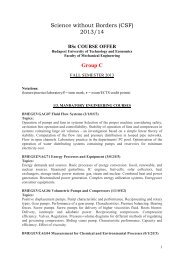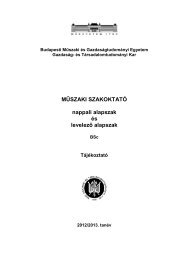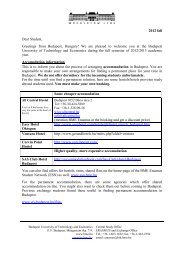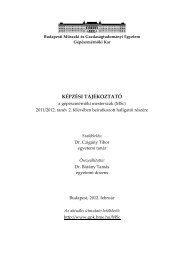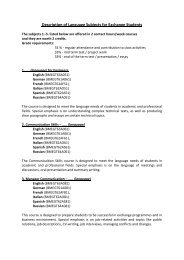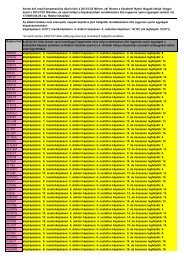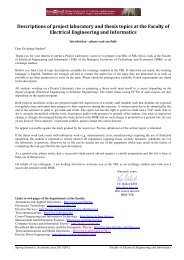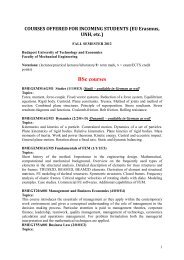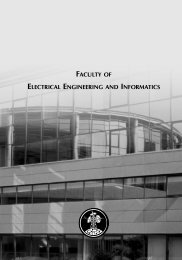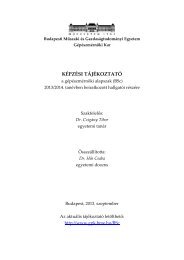FACULTY OF CHEMICAL TECHNOLOGY AND BIOTECHNOLOGY
FACULTY OF CHEMICAL TECHNOLOGY AND BIOTECHNOLOGY
FACULTY OF CHEMICAL TECHNOLOGY AND BIOTECHNOLOGY
You also want an ePaper? Increase the reach of your titles
YUMPU automatically turns print PDFs into web optimized ePapers that Google loves.
<strong>FACULTY</strong> <strong>OF</strong> <strong>CHEMICAL</strong> <strong>TECHNOLOGY</strong> <strong>AND</strong> BIO<strong>TECHNOLOGY</strong>Description of M.Sc. SubjectsGeneral SubjectsDifferential EquationsDr. János TóthExplicit first order ordinary differential equartions and theirsolution. Existence, uniqueness, continuous dependence ondata. Estimating the error of the model and that of the measurements.The simplest types. Linear systems. Higher orderequations. Laplace transform and its applications. Elements ofthe qualitative theory. Elements of partial differntial equations.Complex and Organometallic ChemistryBMEVESAM101Dr. Ilona KovácsHistory of organometallic chemistry. Definitions. Groupingof organometallic compounds. General properties oforganometallic compounds. Synthesis of organometalliccompounds. Characteristic reactions. Homogen catalysis.Synthesis, structure and characteristic reactions of Li- and Mgorganiccompounds (substitution and addition reactions,metalation and transmetalation, catalytic reactions). Synthesis,structure and characteristic reactions of Al-organic compounds(polymer catalyst, Ziegler-Natta catalyst, synthesis ofa-olefins and a-alcohols, olefin dimerization, preparation oforganometallic compounds, preparation of high purity inorganicmaterials). Sn-organic compounds: synthesis, structure,and characteristic reactions (hydrostannation, hydrostannolysis,radical reactions, organostannylenes, redistribution reactions).Application as polymer catalyst, stabilizer, curingagent, and pharmaceutical. Ti-organic compounds: synthesisand characteristic reactions (substitution and insertion reactionsof alkines, reactions of aldehydes and ketones, reductivcoupling and elimination with Ti-organic compounds, polymercatalysts). Cr-organic compounds: synthesis, characteristicreactions, substitution reactions, reactions on the organicligand, rections of carben complexes. Fe-organic compounds:synthesis, characteristic reactions, Friedel-Crafts acylation,Mannich reaction, metalation, cyclization, polymerization.Co-organic compounds: synthesis, characteristicreactions, cyclization of acetylenes and olefins, Pauson-Khand reaction, carbonylations. Rh-organic compounds: synthesis,characteristic reactions, hydrogenations, hydrometalations,decarbonylations, carbonylations, hydroformylations,cyclizations. Ni-organic compounds: sysnthesis, characteristicreactions, substitution reactions, carbonylation, oligomerizationof unsaturated hydrocarbons, catalytic reactions, couplingreactions with organic halides. Pd-organic compounds:synthesis, characteristic reactions, insertions, cyclic dimerizations,oxidative reactions with Pd(II) catalysts, Wackerprocess, reactions with Pd(0) catalysts, coupling reactions,Heck arylation, cyclization and carbonylation, cascade reactions.Cu- and Zn-organic compounds: sysnthesis, characteristicreactions (substitution, addition and transmetalation).Organic ChemistryBMEVESZM101Dr. Péter HuszthyIn the frame of this subject the teaching of basic knowledgein modern organic chemistry is carried out at anadvanced level. The aim of the subject is to make acquaintedthe M.Sc students with the theory, the molecular structures,the stereochemistry, the kinetics and the synthetic strategiesapplicable in organic chemical reactions taking place in idustrialsytheses, in plastic industry, in biochemical processesand in the environment. The subject also deals with the theoryof planning syntheses which extend from stereoselectivemethods to combinatorial chemistry. This subject from onehand expands and develops further the knowledge and wayof thinking of students in the area of organic chemistry andfrom the other hand establishes the organic chemistry basicsin their studies of industrial, process-engineering, analytical,material, pharmaceutical, plastic, polymer, fiber and syntheticchemistries and also of stereochemistry.The theory andapplication of the most important types of reactions: nucleophilicand electrophilic substitutions, addition to multiplecarbon-carbon bonds, polymerization, elimination, nucleophilicaddition and addition-elimination at carbonyl groups,nucleophilic addition and addition-elimination at conjugatedsystems, polycondensation, ring closing and ring openingreactions, processes accompanied by rearrangements. Simplereactions and polimerizations taking place by radical mechanism.Static stereochemistry and dynamic stereochemistry.Basics of planning synthesis; kinetical, molecule structuraland stereochemical aspects in planning synthesis. Planning ofsynthesis: retrosynthetic analysis. Synthetic strategies: linearand convergent syntheses, synthons, inverse synthons, syntheticequivalents, stereochemical questions. Using of heterocyclesand natural products (sugars, amino acids, alkaloidsand their synthetic analogues) in organic syntheses. Bio- andchemo-catalysis: regio- and stereoselectivity. Applying ofenantioselective synthetic methods in building up of complexnatural products containing more than one stereocenters.Special synthetic technics. Chemical syntheses using solidsupports. The basics of combinatorial chemistry. The theoryof molecular recognition and its use in analytical and separationtechnics.Analytical ChemistryBMEVESAM102Dr. György HorvaiMaterials science: traditional structuralmaterials and polymersBMEVEFAM101Dr. Béla Pukánszky1. Definition and significance of materials science.2. Metals and metal matrix composites.3. Traditional and advanced engineering ceramics:production, properties, application.4. Ceramic layered structures. Ceramic-ceramic composites.5. Ceramic-metal combinations.6. Polymers as structural materials.7. Polymers, fibers, composites.8. Nano materials.9. Natural polymers.10. Structural materials from wood.11. Visits at plants and institutes (TVK, MTA MFA).Chemical process design and controlBMEVEKFM101Dr. Péter Mizsey, Katalin KoczkaThe basics of process design, synthesis. Heuristic and algorithmicapproaches. Environmental considerations.Flowsheeting. Chemical reactors and their modelling.Modelling of separators. Utilities, energy integration, heatexchanger network. Exergy and exergy analysis. Combinedprocess design strategy. Batch process scheduling and design.Life cycle analysis and assessment. Control of SISO andMIMO systems. Basic control solutions, flow control, levelcontrol. pressure control, temperature control. Control of differentprocesses.77



